
DM
™
302 Owner’s manual
300 Series
La pagina si sta caricando...

1
INTRODUCTION
Thank you for purchasing B&W DM300 Series
speakers.
Since its foundation in 1966, the continuing
philosophy of B&W has been the quest for
perfect sound reproduction. Inspired by the
company’s founder, the late John Bowers, this
quest has entailed not only high investment in
audio technology and innovation but also an
abiding appreciation of music to ensure that the
technology is put to maximum effect.
It is also our policy to make sure the advanced
features pioneered on one product are
incorporated into others we manufacture.
The rear panel of the DM™302 cabinet is
formed into a wedge pattern similar to the
interior of an anechoic chamber. This greatly
helps to break up the regular internal cabinet
volume that would otherwise encourage
coloration from internal standing waves.
Homogeneous fibre cone bass/midrange
drive units are used for minimum coloration
and maximum definition. The DM™302 also
features a soft dome tweeter with magnetic
fluid cooling to ensure good definition to the
limits of audibility and maintain dynamics to
high sound levels.
However, no matter how good the speakers
themselves, they must work well into the listening
room and time spent on the installation process
will reap the reward of many hours listening
pleasure. Please read through this manual fully.
It will help you optimise the performance of your
audio system.
B&W distribute to over 50 countries world-wide
and maintain a network of dedicated distributors
who will be able to help should you have any
problems your dealer cannot resolve.
UNPACKING
(figure 1)
• Fold the top carton flaps right back and
invert the carton and contents.
• Lift the carton clear of the contents.
• Remove the inner packing from the product.
We suggest you retain the packaging for
future use.
CONNECTIONS
(figure 2)
All connections should be made with the
equipment turned off.
Connect the positive terminal on the speaker
(marked + and coloured red) to the positive
terminal on the power amplifier and negative
(-, black) to negative (figure 2). Failure to
observe correct polarity will result in poor
sound balance and image focusing.
Always make sure all the terminal caps are
screwed down tight, as otherwise they
may rattle.
When choosing cable, keep the total electrical
impedance (out and back) below the maximum
recommended in the specification. In particular,
the cable to the tweeter should have low
inductance, otherwise the very high frequencies
will be attenuated. Ask your dealer for advice,
as the optimum cable will depend on the length
required.
POSITIONING
(figure 3)
Some experimentation with the position of the
speakers is well worthwhile to optimise the
interaction between them and the listening room.
However, as an initial guide:
Place the speakers on firm stands or bookshelves
that place the tweeters approximately at ear
level.
Place the speakers and the centre of the listening
area approximately at the corners of an
equilateral triangle.
Keep the speakers at least 1.5m (5ft) apart to
maintain left-right stereo separation.
Keep the speaker baffles at least 0.5m (20in)
clear of walls. Having the speakers too close to
walls increases the level of bass relative to the
midrange and may give a boomy quality to the
sound.
NOTE: The DM™302 produces a static
magnetic field that extends outside the cabinet
boundary. As such The DM™302 should not be
placed within 0.5m (20in) of equipment that
may be affected by such a field, e.g. Cathode
Ray Tubes in TVs and Personal Computers.
FINE TUNING
Before fine tuning the installation, double check
the polarity and security of the connections.
If the level of bass is uneven with frequency, this
is usually due to strong excitation of resonance
modes in the room.
Even small changes in the position of the
speakers within the listening room can have a
profound effect on the perceived sound quality
by altering the excitation of these modes. Try
mounting the speakers along a different wall.
Even moving large pieces of furniture about can
have an effect.
If the general level of bass is too high, try
moving the speakers further away from the walls.
Conversely, if you need more bass, move the
speakers closer to the walls. Space behind the
speakers also improves the impression of
perspective on well recorded material.
If the central image is poor, try moving the
speakers closer together or toeing them in so
they point at or just in front of the listening area
(figure 4).
If the sound is too harsh, increase the amount of
soft furnishing in the room. For example, use
heavier curtains. Conversely reduce the amount
of soft furnishing if the sound is dull and lifeless.
Test for flutter echoes by clapping your hands
and listening for rapid repetitions. These can
smear the sound, but may be reduced by
irregular shaped surfaces such as bookshelves
and large pieces of furniture.
Ensure the speakers are firmly supported.
Speaker stands should be regarded as part of
the speaker and chosen with care. Ask your
dealer for advice on the best stands for your
needs.
AFTERCARE
The vinyl veneers normally only require dusting.
If you wish to use an aerosol cleaner, remove
the grille first by gently pulling it away from the
cabinet. Spray onto the cleaning cloth, not
directly onto the cabinet. The grille fabric may
be cleaned with a normal clothes brush after
removing the grille from the cabinet.
Avoid touching the drive units, especially the
tweeter, as damage may result.
La pagina si sta caricando...
La pagina si sta caricando...
La pagina si sta caricando...
La pagina si sta caricando...
La pagina si sta caricando...
La pagina si sta caricando...

PORTUGUÊS
INTRODUÇÃO
Gratos pela sua aquisição das colunas B&W da
série DM300.
Desde a sua fundação em 1966, a filosofia da
B&W tem estado ligada à procura contínua da
reprodução sonora perfeita. Inspirada pelo
fundador da companhia, o falecido
John Bowers, esta busca não só tem acarretado
um elevado investimento em tecnologia de áudio
e inovação, mas também uma permanente
avaliação em termos musicais para assegurar o
pleno efeito das soluções tecnológicas.
O painel posterior da caixa da DM™302 é
formado a partir de um padrão semelhante ao
interior de uma câmara anecóica. Isto constitui
uma grande ajuda para tornar irregular a
superfície interna da caixa que de outra forma
ajuda a criação de ondas estacionárias
internas. São também utilizados altifalantes de
médios/baixos de fibra homogénea para
mínima coloração e máxima definição. A
DM™302 possui também um tweeter de cúpula
macia com arrefecimento por fluído magnético
para assegurar uma boa definição até aos
limites da gama audível, e manter a gama
dinâmica até elevados níveis de pressão sonora.
No entanto, por muito boa que seja a
qualidade intrínseca das colunas, elas têm de
funcionar bem na sala de audição e o tempo
gasto com a respectiva instalação fornecerá
dividendos sob a forma de muitas horas de
prazer auditivo. Leia por favor a totalidade
deste manual. Ele ajuda-o a optimizar o
desempenho do seu sistema de áudio.
A B&W é distribuída em mais de 50 países do
mundo inteiro e mantém uma rede de dedicados
distribuidores que poderão ajudar quando
existirem quaisquer problemas que ultrapassem o
seu revendedor.
DESEMBALAGEM
(figura 1)
• Dobre as abas superiores da caixa e inverta-a
junto com o respectivo conteúdo.
• Levante a caixa deixando sair o conteúdo.
• Retire a embalagem interior.
Sugerimos que guarde a embalagem para
utilização futura.
LIGAÇÕES
(figura 2)
Todas as ligações devem ser efectuadas com a
alimentação desligada.
Ligue o terminal positivo da coluna (vermelho
com a marca +) ao terminal positivo do
amplificador de potência e o terminal negativo
(-, preto) ao negativo (figura 2). Se não for
respeitada a polaridade correcta o resultado
será o desequilíbrio e desfocagem da imagem
sonora.
Assegure-se sempre de que as porcas de todos
os bornes estão bem apertadas, mesmo quando
utiliza fichas banana, pois de outra forma
poderão provocar ruído.
Quando escolher o cabo, mantenha a
impedância (de ida e volta) abaixo do valor
máximo indicado nas características. O cabo do
altifalante de agudos, em particular, deve
possuir uma impedância baixa, de outro modo
as frequências mais altas serão atenuadas.
Consulte o seu revendedor, uma vez que o tipo
de cabo a utilizar depende do comprimento
necessário.
COLOCAÇÃO
(figura 3)
Vale a pena efectuar vários ensaios com a
colocação das colunas para optimizar a
interacção entre elas e a sala de audição. No
entanto, para início siga as indicações
seguintes:
Coloque as colunas em suportes ou prateleiras
firmes de modo a que os tweeters fiquem
posicionados aproximadamente à altura do
ouvido.
Coloque as colunas de forma a que estas e o
centro da zona de audição fiquem colocadas
aproximadamente nos pontos que correspondem
aos vértices de um triângulo equilátero.
Mantenha as colunas com um afastamento de
pelo menos 1,5 m para manter a separação
estéreo entre os canais esquerdo e direito.
Mantenha a parte frontal da coluna a pelo
menos 0,5 m das paredes. Se as colunas
estiverem demasiado próximo da parede o nível
de baixos ficará reforçado em relação à gama
média e o som poderá adquirir uma
característica ribombante.
NOTA: As DM™302 produzem um campo
magnético estático que ultrapassa as paredes da
caixa. Assim, estas colunas não devem ser
colocadas a menos de 0,5 metros de
equipamentos que possam ser afectados por
esse campo, por exemplo Tubos de Raios
Catódicos de televisores e Computadores
Pessoais.
AJUSTE FINO
Antes de efectuar o ajuste fino da instalação,
verifique novamente a polaridade e o aperto
das ligações.
Se o nível de baixos estiver desequilibrado ao
longo da gama, isto deve-se normalmente à
forte excitação dos modos de ressonância da
própria sala.
Mesmo as pequenas alterações na colocação
das colunas no interior da sala de audição
podem produzir um grande efeito na qualidade
de som ao alterar a excitação dos referidos
modos de ressonância. Experimente a montagem
das colunas junto a outra parede. Mesmo a
deslocação de móveis de grandes dimensões
pode produzir efeitos.
Se o nível geral de baixos for demasiado
elevado, experimente afastar um pouco as
colunas da parede. Se, por outro lado,
necessitar de mais baixos, desloque as colunas
para o lado da parede. O espaço atrás das
colunas melhora também a noção de
perspectiva em registos de qualidade.
Se a imagem central é fraca, experimente
colocar as colunas mais próximas ou rodá-las
um pouco para dentro de forma a que fiquem
apontadas para um ponto imediatamente à
frente da zona de audição (figura 4).
Se o som for demasiado agreste, aumente a
quantidade de mobiliário de tipo macio na sua
sala. Utilize por exemplo cortinas mais pesadas.
Se, pelo contrário, o som for macilento e sem
vida, reduza a quantidade de mobiliário deste
tipo.
Verifique a existência de ecos batendo as
palmas e escutando rápidas repetições. Estas
podem deturpar o som, mas podem ser
reduzidas pela existência de superfícies
irregulares como prateleiras e grandes peças de
mobiliário.
Assegure-se que as colunas estão firmemente
apoiadas. Os suportes de colunas devem ser
vistos como parte da coluna e escolhidos com
cuidado. Consulte o seu revendedor para se
aconselhar sobre os melhores suportes para as
suas necessidades.
CUIDADOS POSTERIORES
Os folheados de vinil normalmente apenas
necessitam de limpeza do pó. Se pretender
utilizar um produto de limpeza em aerosol, retire
em primeiro lugar a grelha afastando-a
suavemente da coluna. Coloque o spray no
pano de limpeza, e não directamente sobre a
coluna. A grelha poderá ser limpa com uma
escova macia depois de retirada da caixa.
Evite tocar nos altifalantes, especialmente no de
agudos, pois poderá provocar danos.
8
La pagina si sta caricando...

Description
Drive units
Frequency range
Frequency response
Dispersion
Sensitivity
Harmonic distortion
Nominal impedance
Crossover frequency
Recommended
amplifier power
Max. Recommended
Cable impedance
Dimensions
Net weight
DM™302
B&W Loudspeakers Ltd. reserves the right to amend specifications without notice in line with technical developments. Copyright © B&W Loudspeakers Ltd.
B&W Loudspeakers Ltd, Meadow Road, Worthing, BN11 2RX, England Tel: +44 (0) 1903 524801 Fax: +44 (0) 1903 524725.
B&W Loudspeakers of America, 54 Concord Street, North Reading, MA 01864-2699 Tel: (1978) 664 2870 Fax: (1978) 664 4109.
B&W Loudspeakers (Asia) Ltd, Flat U, 11F Camelpaint, Building Block 111, 60 Hoi Yuen Road, Kwun Tong, Kowloon, Hong Kong.
Tel: (8522) 790 8903 Fax: (8522) 341 2777. http://www.bwspeakers.com Printed in England.
2-way 4th-order vented-box system
1x 125mm (5in) Homogeneous fibre bass/mid
1x 26mm (1in) soft dome high-frequency
-6dB at 60Hz and 22kHz
72Hz – 20kHz ±3dB on reference axis
Within 2dB of response on reference axis
Horizontal: over 40° arc
Vertical: over 10° arc
91dB spl (2.83V, 1m)
2nd & 3rd harmonics <1% 92Hz – 20kHz (90dB spl, 1m)
8Ω (minimum 3.2Ω)
3kHz
25W –100W continuous into 8Ω on unclipped programme.
0.2Ω
Height: 320mm (12.6in)
Width: 185mm (7.3in)
Depth: 208mm (8.2in)
4.1kg (9 lb)
I I 04634 Issue 3
-
 1
1
-
 2
2
-
 3
3
-
 4
4
-
 5
5
-
 6
6
-
 7
7
-
 8
8
-
 9
9
-
 10
10
-
 11
11
-
 12
12
B&W 300 Series Manuale del proprietario
- Categoria
- Altoparlanti
- Tipo
- Manuale del proprietario
in altre lingue
- English: B&W 300 Series Owner's manual
- français: B&W 300 Series Le manuel du propriétaire
- español: B&W 300 Series El manual del propietario
- Deutsch: B&W 300 Series Bedienungsanleitung
- Nederlands: B&W 300 Series de handleiding
- português: B&W 300 Series Manual do proprietário
- dansk: B&W 300 Series Brugervejledning
Documenti correlati
-
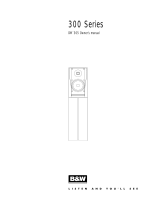 Bowers & Wilkins 300 Series Manuale del proprietario
Bowers & Wilkins 300 Series Manuale del proprietario
-
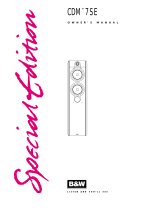 Bowers & Wilkins CDM 7 Manuale utente
Bowers & Wilkins CDM 7 Manuale utente
-
B&W DM 601 Manuale del proprietario
-
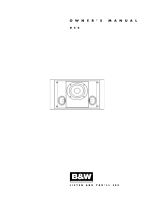 Bowers & Wilkins DS6 Manuale del proprietario
Bowers & Wilkins DS6 Manuale del proprietario
-
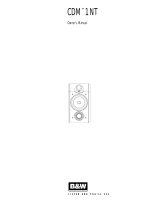 Bowers & Wilkins CDM 1NT Manuale del proprietario
Bowers & Wilkins CDM 1NT Manuale del proprietario
-
Bowers & Wilkins CDM 7NT Manuale utente
-
Bowers & Wilkins LCR 60 Manuale del proprietario
-
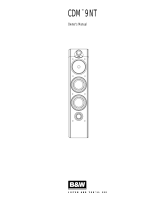 Bowers & Wilkins CDM 9NT Manuale utente
Bowers & Wilkins CDM 9NT Manuale utente
-
B&W DM 601 S3 Manuale del proprietario
-
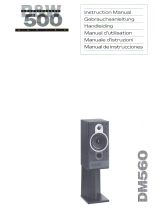 Bowers & Wilkins DM 560 Manuale del proprietario
Bowers & Wilkins DM 560 Manuale del proprietario

















